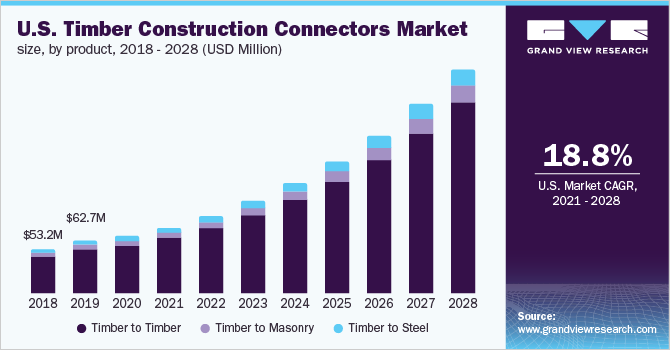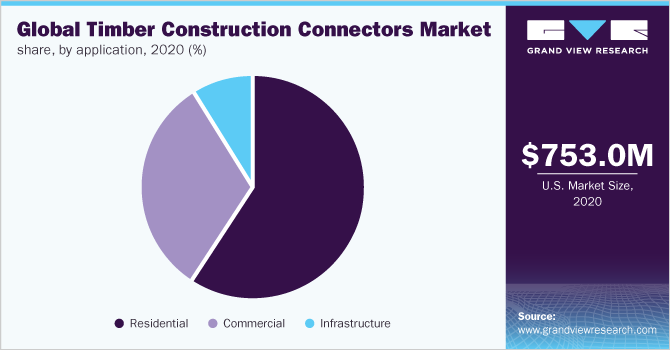- Home
- »
- Advanced Interior Materials
- »
-
Timber Construction Connectors Market Report, 2028GVR Report cover
![Timber Construction Connectors Market Size, Share & Trends Report]()
Timber Construction Connectors Market Size, Share & Trends Analysis Report By Product (Timber To Timber, Timber To Masonry, Timber To Steel), By Application, By Region, And Segment Forecasts, 2021 - 2028
- Report ID: GVR-4-68038-383-6
- Number of Report Pages: 105
- Format: PDF, Horizon Databook
- Historical Range: 2017 - 2019
- Forecast Period: 2021 - 2028
- Industry: Advanced Materials
Report Overview
The global timber construction connectors market size was valued at USD 753.0 million in 2020 and is expected to expand at a compound annual growth rate (CAGR) of 13.9% from 2021 to 2028. The growing demand for wood-based constructions on account of the superior aesthetic appeal in the residential and commercial constructions is expected to drive the market. The suspension of construction activities in 2020 to curb the spread of the COVID-19 outburst has negatively impacted the wood construction activities, thus hampering the demand for connectors. Supply chain disruption and termination of trade activities across the globe emerged as the other key factors hampering market growth.

As per the reports by the U.S. Department of Agriculture, the demand for wood construction in the country is likely to double every two years till 2030, which is anticipated to offer growth prospects to the connectors market. Moreover, a rise in the demand for wooden construction, especially for residential and commercial construction projects, is anticipated to support the market growth.
The demand for timber construction is likely to increase in the upcoming years on account of a rise in the demand for sustainable constructions. Socio-ecological advantages of green constructions, along with the proliferation of Mass Engineered Timber (MET) products, are expected to increase the demand for timber construction in the coming years. Major benefits of timber construction include reduced Co2 emissions and carbon consumption and biophilic design.
Mass timbers, cross-laminated timber, wood panels, and other wood-based products are widely being accepted in construction projects, which is driving the demand for specialized connectors. Advancements in the production of fastening components have led to the introduction of durable connectors, including rings, plates, and rods, which can hold heavy wooden beams and panels firmly.
In Germany, the recent revision of the International Building Code (IBC) in 2021 has eased the construction approval process for wooden structures. Owners are now allowed the certificates to construct wooden premises up to 18 stories. Several economies across the globe, where timber production is abundant, are aiming to incorporate these new building codes for timber projects.
Product Insights
Timber to timber construction connectors accounted for the largest revenue share of over 80.0% in 2020. Timber-to-timber connectors used in construction applications include split rings that are installed in pre-cut grooves. These rings are deployed in split shape in routed grooves between different timber components and they reduce stress at connection points of structures.
The key components used for connecting timber to masonry include angle brackets, joist hangers, restraint straps, and other standard plates. These products are manufactured in a variety of shapes and sizes to match the requirements of construction projects as the beam size is not specified across wood construction. Specialized hangers are commercially available that can be used as mild joints with insulated concrete forms in wooden structures.
Shear plates and toothed plates are widely used for bonding applications in wooden construction. Shear plates are installed in pre-cut grooves that can also flush into the timber surface with steel side plates or wood side plates. Toothed plates are installed by simply pressing them into the timber.
Toothed plate connectors are mostly available in circular, oval, and square shapes. They can be fixed into the timber with the help of connectors, bolts, or screws. The rise in demand for wooden construction based on heavy- and large-size beams and panels is anticipated to increase the demand for timber to steel connectors across the world.
Application Insights
The residential application segment led the market and accounted for a revenue share of more than 55.0% in 2020. Timber is sustainable and aesthetically pleasing in residential applications. Mass Engineered Timber (MET) is used for several applications including framing, casework, paneling, flooring, trims, cabinets, and interior design components owing to the superior qualities it offers as compared to conventional wood. Besides, it is popularly used for decorative applications due to its aesthetic appeal.
Increasing awareness regarding mass timber construction in the U.S. is projected to drive wooden construction significantly in the upcoming years. The high demand for wooden construction projects in residential applications in Canada is also likely to have a positive impact on the demand for timber connectors as these products offer enhanced strength to the overall wood structures.

The commercial construction segment includes office buildings, government offices, shopping malls, hypermarkets, departmental stores, restaurants, hotels, resorts, and others. Modern trends for aesthetic improvements have penetrated the utilization of wooden structural components, which is supporting the demand for connectors.
Infrastructure applications for timber construction are still underway as it is less sturdy than concrete and cement. Structural developments for the enhancement of wooden strength are being investigated by governing authorities and industry participants. Thus, the demand for timber construction connectors is limited in infrastructure applications. However, the adoption of a wooden framework in multiple infrastructure projects, including towers, bridges, and others, is expected to propel the demand for construction connectors.
Regional Insights
Europe dominated the market and accounted for a revenue share of over 35.0% in 2020. High penetration of wood-based constructions, especially in countries such as Germany, Sweden, and France, is expected to drive the demand for products. Moreover, under the program Build-in-wood by Horizon 2020, the proportion of timber construction is projected to ascend, thereby positively influencing the growth of the timber connectors market.
Germany is likely to be the largest shareholder in the European market over the forecast period. This can be attributed to the high penetration of wood-based houses in the country and increasing trends for eco-friendly constructions. The government of Germany introduced the Housing Construction Campaign in an attempt to deal with the rising prices and the shortage of housing in the country. This is expected to aid the growth of the construction market and support the demand for timber connectors.
The market for timber construction connectors in the U.S. is anticipated to ascend at a significant rate in the projected timeframe. This trend is likely to be supported by a rise in the demand for wooden construction, especially for residential and commercial construction projects.
The Wood Encouragement Policy in Australia promotes the use of responsibly sourced wood as a construction material for new public buildings and refurbishment construction projects. Moreover, rising awareness among consumers regarding the energy efficiency of building structures and utilization of eco-friendly construction materials is projected to augment the demand for wood construction in both residential and commercial segments.
Key Companies & Market Share Insights
The market for timber construction connectors is likely to ascend at a high rate on account of a rise in the adoption of wood-based construction across the globe. Increasing production of connectors to meet the rising demand from the end-use segments has pushed the market with slight competitiveness. For instance, the expansion of the existing facility by E.u.r.o.Tec GmbH to enhance its production for bonding components has ascended the company’s product offerings and has created a competitive advantage in the market. Some prominent players in the global timber construction connectors market include:
-
Pryda (ITW, Inc.)
-
Simpson Strong Tie Co., Inc.
-
MITEK INC.
-
Timberplates
-
Connext Post and Beam
-
Knapp GmbH
-
Eurotec GmbH
-
MTC Solutions
-
BPC Fixings (The Vista Group)
-
Globus Industries
-
CQFD
-
Taurus India Limited
Timber Construction Connectors Market Report Scope
Report Attribute
Details
Market size value in 2021
USD 838.3 million
Revenue forecast in 2028
USD 2.14 billion
Growth Rate
CAGR of 13.9% from 2021 to 2028
Base year for estimation
2020
Historical data
2017 - 2019
Forecast period
2021 - 2028
Quantitative units
Revenue in USD million and CAGR from 2021 to 2028
Report coverage
Revenue forecast, company ranking, competitive landscape, growth factors, and trends
Segments covered
Product, application, region
Regional scope
North America; Europe; Asia Pacific; Central & South America; Middle East & Africa
Country scope
U.S.; Canada; Mexico; Germany; U.K.; France; Italy; Russia; China; India; Japan; South Korea; Australia; Southeast Asia; Brazil; Argentina
Key companies profiled
Pryda (ITW, Inc.); Simpson Strong Tie Co., Inc.; MITEK INC.; Timberplates; Connext Post and Beam; Knapp GmbH; Eurotec GmbH; MTC Solutions; BPC Fixings (The Vista Group); Globus Industries; CQFD; Taurus India Limited
Customization scope
Free report customization (equivalent up to 8 analysts working days) with purchase. Addition or alteration to country, regional & segment scope.
Pricing and purchase options
Avail customized purchase options to meet your exact research needs. Explore purchase options
Segments Covered in the ReportThis report forecasts revenue growth at the global, regional, and country levels and provides an analysis of the latest industry trends and opportunities in each of the sub-segments from 2017 to 2028. For the purpose of this study, Grand View Research has segmented the global timber construction connectors market report on the basis of product, application, and region:
-
Product Outlook (Revenue, USD Million, 2017 - 2028)
-
Timber to Timber
-
Timber to Masonry
-
Timber to Steel
-
-
Application Outlook (Revenue, USD Million, 2017 - 2028)
-
Residential
-
Commercial
-
Infrastructure
-
-
Regional Outlook (Revenue, USD Million, 2017 - 2028)
-
North America
-
U.S.
-
Canada
-
Mexico
-
-
Europe
-
U.K.
-
Germany
-
France
-
Italy
-
Russia
-
-
Asia Pacific
-
China
-
India
-
Japan
-
South Korea
-
Australia
-
Southeast Asia
-
-
Central & South America
-
Brazil
-
Argentina
-
-
Middle East & Africa
-
Frequently Asked Questions About This Report
b. The global timber construction connectors market size was estimated at USD 753.0 million in 2020 and is expected to reach USD 838.3 million in 2021.
b. The global timber construction connectors market is expected to grow at a compound annual growth rate of 13.9% from 2021 to 2028 to reach USD 2.14 billion by 2028.
b. Residential construction applications dominated the timber construction connectors market with a share of 59.2% in 2020. This is attributed to the rise in demand for wood-based constructions across the globe.
b. Some of the key players operating in the timber construction connectors market include Pryda; MITEK INC.; Timberplates; Simpson Strong-Tie; Connext Post and Beam; Knapp GmbH; Eurotec GmbH; MTC Solutions; and BPC Fixings (The Vista Group).
b. The key factors that are driving the timber construction connectors market include rising demand for wood-based construction, especially for residential units.
Share this report with your colleague or friend.
![gvr icn]()
NEED A CUSTOM REPORT?
We can customize every report - free of charge - including purchasing stand-alone sections or country-level reports, as well as offer affordable discounts for start-ups & universities. Contact us now
![Certified Icon]()
We are GDPR and CCPA compliant! Your transaction & personal information is safe and secure. For more details, please read our privacy policy.
We are committed towards customer satisfaction, and quality service.
"The quality of research they have done for us has been excellent."





